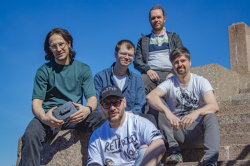What kind of research do you do with your team in Tel Aviv?
We have been working on two main topics: nonlinear topics and Bose-Einstein condensates. On the one hand, these are completely different topics; the former concerns optical physics, while the latter pertains to atomic physics. But they have much in common in regards the theory: mathematical models, technical analysis, system dynamics. Many theorists, like me, work in both of these fields at the same time.
What is their practical application?
There are many. Non-linear optics are used everywhere and they have a wide range of applications. For instance, look at how we transmit data. Today, copper wiring has been replaced with optical fibers. We lay it between cities and even entire continents. There are long-range lines between America and Europe, or America and Asia. They lie on the ocean floor, stretching for thousands of kilometers. On one end of a line there is a light signal generator, a laser that sends pulses forward. Of course, these pulses are going to be lost without our help; at those distances, they’ll just dissipate. That’s why there are automated amplifiers embedded in the line, powered by a parallel power cable. The amplifiers catch a signal and push forward a copy.

Optical fibers themselves are made of quartz glass (silica), which is the best material for data transfer, as polymers suffer more signal loss. But even glass is not perfect. In the 19th century, the Scottish physicist John Kerr had made a discovery which implied that signals are distorted due to non-linear effects. In other words, you send one signal and receive another. The effect is unavoidable, as it is a property of the material.
On the scale of one city, the effect is negligible, but if you were to send a signal from, say, St. Petersburg to Novosibirsk, the non-linearity will distort the pulse and change its speed. It doesn’t matter if it comes a bit too early or a bit too late: there will an error and, therefore, issues. Thus, the Kerr effect is important, but not beneficial.
And you, along with other researchers, have found a different solution?
Yes. Our solution is not to fight the non-linearity, but to exploit it. We can launch a short, powerful pulse, which stimulates the dispersion. As a combination of non-linearity and dispersion, we’ll end up with a light pulse capable of sustaining its own form. The non-linearity makes parts of the wave draw each other closer. It’s like a wave that contains a single crest. It doesn’t generate ripples and sustains itself. All you have is a self-sustaining, non-linear light pulse, which is called a soliton (a solitary wave).

As for practical applications, the idea was that data can be transmitted over optical fibers using solitons put together in a chain. Solitons make communication more stable, as you no longer need to suppress the Kerr non-linearity, which is unavoidable anyway.
The suggestion was well-received. Major telecommunications companies had invested billions of dollars into the project in hopes of increasing their data transfer rates. But when it came to commercial applications, only a single line was ever built. It was laid down in 2002, between the Australian cities of Adelaide and Perth, three thousand kilometers apart. The story went so: the system was put in place by a British company that went bankrupt. The line was ordered by a local company that, too, went bankrupt. In the end, it was purchased by the major Australian provider Telstra, who used it as a back-up option. When there is too much traffic on their primary link between the two cities, they use this one to share the load.
So companies just decided not to use the more effective technology?
It is a better technology, but this is about business, not physics. I don’t have all the details, but as far as I’m aware, providers came to the conclusion that there are other ways of improving speeds without making use of solitons. Ways that were simpler and cheaper. They could have replaced the peripherals; compared to the cost of the line itself, the costs of that are quite small. But they don’t want to have to retrain all of their staff who have spent years working on the regular lines.

How do you feel about a technology that you worked on, which could have improved communications, not seeing a practical application?
To theoretical scientists such as me, the work was all about solving interesting physics problems. It wasn’t like we were contractors who had to account for our expenses. We wrote articles, submitted them to journals, and didn’t earn much for it. Perhaps they’ll send you to a conferences and cover your expenses, but that’s it.
It is, indeed, a pity; it was a promising technology that resulted in nothing but a single line in Australia. Nevertheless, non-linear optics are not dead. The science continues to develop rapidly in many areas, not just telecommunications. Right now, I study solitons in Bose-Einstein condensates. First, we cool a gas to extremely low temperature and observe how some atoms, instead of pushing away from each other, come together and form solitons. The technology can be used to create high-precision atomic clocks and quantum computers. But it’ll be a while before we see these devices completed.
How did you start working with ITMO University?
A renowned scientist and a corresponding member of the Russian Academy of Sciences, Nikolai Rozanov, works at the University. He is, too, a theoretical scientist and we have many shared interests. He and I have worked on similar theoretical models.

I had not met him back when I worked in Russia, before 1991. We met later, during several conferences, and found ourselves interested in similar subjects. We co-authored several articles, including one on the subject of laser cavity modeling. After one such conference, he invited me to join ITMO as an associate researcher.
What advantages do you get from working with ITMO University?
ITMO University is one of the leaders in non-linear optics research, my primary field of studies. Naturally, it made sense for me to work with the University.
Right now I work closely with two universities on a quasi-constant basis: ITMO University and The Institute of Photonic Sciences in Barcelona; by the way, their acronym, ICFO, if very similar to yours. At ICFO, we collaborate with a well-known Russian scientist, Yaroslav Kartashov, an expert on numerical simulations and optical physics. I’m not a specialist on numerical methods, that is why being able to work with him is very beneficial. He’s a real guru of his trade.
Every year, I spend a week at ITMO and one week at ICFO. Another place I visit once a year is the city of Guangzhou in China.

Do you like traveling this often?
Generally, yes. I’ve lived like this for more than 25 years. My wife, who lives in Israel, says I spend half the year abroad, but that’s an exaggeration: it’s only four and a half months. I don’t feel stressed by any of this traveling.
Do you have any plans for future collaborations with ITMO University? What subject would you like to work with?
We’re currently discussing possible topics of future research. The general direction is clear: it is, of course, non-linear optics. Namely, various soliton-related models. Two ITMO researchers, Alexey Yulin and Dmitry Zezyulin, have been collaborating with me on scientific articles. I had originally met both of them in Portugal, and later they found work here, at ITMO. Then there is, of course, Professor Nikolai Rozanov. I’ll be glad to continue and develop our partnership with the researchers at ITMO University.





